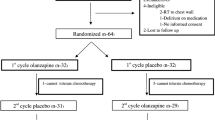Abstract
The objective of this study is to compare the effectiveness of olanzapine combined with ondansetron or ondansetron alone in preventing chemotherapy-induced nausea and vomiting (CINV) of non-small cell lung cancer (NSCLC). A total of 84 NSCLC patients were equally randomized into intervention group and control group. Both groups were intravenously administered with ondansetron 8 mg 30 min before chemotherapy. In the intervention group, olanzapin 10 mg was orally administered for 8 days, beginning from the first morning of chemotherapy. The antiemetic effectiveness was evaluated in the first chemotherapy cycle. The incidence of acute vomiting was 33.33 % (14/42) and 54.76 % (23/42) in the intervention group and control group (p < 0.05) whereas that of delayed vomiting was 16.57 % (7/42) and 47.62 % (20/42) (p < 0.05). Compared with ondansetron alone, the combination of olanzapine with ondansetron has better effectiveness in preventing CINV in NSCLC patients, particularly for the delayed type.
Similar content being viewed by others
References
Robert, J., Ginsberg, H. J., & Lung, C. (2010). American Cancer Society Clinical Oncology Series (pp. 1–7). Beijing: China Medical Science and Technology Press.
Wiser, W., & Berger, A. (2005). Practical management of chemotherapy-induced nausea and vomiting. Oncology, 05, 637–645.
Shi, Y. K. (2008). Diagnosis and treatment of lung cancer (pp. 240–271). Beijing: People’s Health Publishing House.
Lin, C. (2011). Management of the toxicities of anti-cancer drugs. Programme for Japanese Medicine, 11, 491–493.
Gregory, R.E., Ettinger, D.S. (1998). 5-HT3 receptor antagonists for the prevention of chemotherapy-induced nausea and vomiting. Drugs, 2, 173–189.
Zhang, X.J., Zhang, P. (2009). Advances in mechanism and treatment of chemotherapy-induced nausea and vomiting. Oncology Programme, 4(4), 348–354.
Ma J, Han ZX. (2010). Hemotherapy-induced nausea and vomiting: research advances and management. Journal of Xuzhou Medical College. doi:10.3969/j.issn.1000-2065.2010.09.024.
Navari, R. M., Gray, S. E., & Kerr, A. C. (2011). Olanzapine versus aprepitant for the prevention of chemotherapy-induced nausea and vomiting: a randomized phase Trial. Journal of Support Oncology, 9(5), 188–195.
Passik, S. D., Kirsh, K. L., & Theobald, D. E. (2003). A retrospective chart review of the use of olanzapine for the prevention of delayed emesis in cancer patients. Journal of Pain Symptom Management, 25(5), 485–488.
Bymaster F, Perry KW, Nelson DL (1999) Olanzapine: a basic science update. British Journal of Psychiatry Supplement, 37, 36–40.
He, H., & Richardson, J. S. (1995). A pharmacological, pharmacokinetic and clinical overview of risperidone, a new antipsychotic that blocks serotonin 5-HT2 and dopamine D2 receptor. International Clinical Psychopharmacology, 10(1), 19–30.
Schotte, A., Janssen, P. F., & Gommeren, W. (1996). Risperidone compared with new and reference antipsychotic drugs: in vitro and in vivo receptor binding. Psychopharmacology, 124(1–2), 57–73.
Jordan, K., Kasper, C., & Schmoll, H. J. (2005). Chemotherapy-induced nausea and vomiting: current and new standards in the antiemetic prophylaxis and treatment. European Journal of Cancer, 4(2), 199–205.
Navari, R. M. (2006). Ondansetron, prochlorperazine, and dexamethasone have similar effects on prevention of delayed chemotherapy-induced nausea and vomiting. Cancer Treatment Reviews, 32(1), 50–54.
Author information
Authors and Affiliations
Corresponding author
Additional information
Wang Lei and Wang Xin have contributed equally to the study and should be considered as co-first authors.
Rights and permissions
About this article
Cite this article
Wang, X., Wang, L., Wang, H. et al. Effectiveness of Olanzapine Combined with Ondansetron in Prevention of Chemotherapy-Induced Nausea and Vomiting of Non-small Cell Lung Cancer. Cell Biochem Biophys 72, 471–473 (2015). https://doi.org/10.1007/s12013-014-0489-0
Published:
Issue Date:
DOI: https://doi.org/10.1007/s12013-014-0489-0




